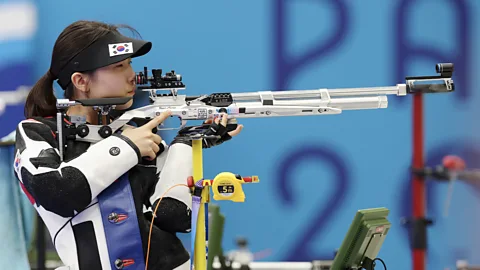The sports where women outperform men
 Getty Images
Getty ImagesFrom ultrarunning to shooting sports, in some competitions women have the edge.
It's been over 40 years, but Penny Lee Dean vividly remembers the cold.
Training was brutal, as Dean prepared for what would be a record-setting swim – regardless of sex – across the English Channel in 1978. "Your hands cramp, your legs cramp," she remembers. After emerging from her practice open-water swims, it would take hours for her to start feeling warm again. A 20-minute hot shower wasn't enough. Neither was a dip in a single hot tub; as soon as one grew cold, she would enter another one cradling a cup of tea.
While the cold was bone-chilling, conquering it has been essential to her success as a record-breaking swimmer. An ability to tolerate extreme cold is one of the advantages that women may have in this sport, as their distribution of fat is helpful for regulating body temperature in cold water. Dean believes that women also have a higher tolerance for discomfort.
In fact, women can outperform or perform similarly to men in a range of competitive events, from sport shooting to ultrarunning. However, the path toward greater inclusion has not been linear, and more questions than answers remain about the role of sex in athletic performance.
A tricky comparison
Øyvind Sandbakk, a professor of sports science at UiT The Arctic University of Norway and the director of the Norwegian School of Elite Sports (NTG), has found together with colleagues that the gaps in the average performance between elite female and male athletes have tended to plateau at around 8–12% difference in world-record results in favour of men. The gap can be significantly smaller for ultra-endurance swimming and larger for sports involving substantial upper-body strength, the study found.
The pool of competitors can also be restricted due to gender bias. Some sports with "aesthetic" elements have been stereotyped as feminine, while martial arts such as boxing are considered less acceptable for women in certain societies. No men are participating in artistic swimming at the Paris Olympics.
It's also very difficult to separate biological and social aspects contributing to differences between women and men in sports performance, Sandbakk stresses. These include unequal access to sport opportunities. And context is essential.
Yet in long-distance events, being more measured with starting speeds and pacing can be an advantage. "Women generally seem to be better pacers, for instance in marathon runners," says Sandbakk. And competitiveness is not just a matter of physiology, but also of social conditioning and psychology. While most research has focused on athletic prowess in children, there are some indications that the social environment surrounding girls can effect their competitiveness compared to boys.
Certainly, according to a scientific concensus issued in 2023 by the American College of Sports Medicine, the differences in athletic performance between girls and boys are "minimal" before puberty then leads to an increasing gap between them. It is worth noting, however, that the data on pre-puberty performance is contradictory, with some studies suggesting young boys do have an athletic edge in track sports, for example.
 Getty Images
Getty ImagesTestosterone levels are generally linked to muscle size and strength, as well as higher haemoglobin concentration and thus better oxygen uptake. It has also been associated with more competitiveness in men. In terms of competitiveness, testosterone influences men's tendency to take more risks, both within and beyond sports.
There is limited research on how testosterone affects women (or how oestrogen affects men). Men and women generally do not have overlapping ranges of testosterone. In her book Better Faster Farther: How Running Changed Everything We Know About Women, Maggie Mertens writes that averages can mask the great diversity of hormone ranges.
There isn't a clear linear relationship between testosterone levels and performance, says Mertens, a journalist focusing on sports and gender. "In fact, a lot of very elite male athletes have pretty low testosterone levels overall on average." One endocrinology study found low testosterone concentrations in one-quarter of men competing in 12 of the 15 Olympic sports analysed. And Mertens says even women with hyperandrogenism, who can have testosterone levels that reach typical male ranges, don't have the same level of performance as men.
An ultradistance edge
Before her English Channel record, Dean had also set a new outright record for the fastest swim of the Catalina Channel, off the coast of Los Angeles, California. She crossed this 32.5-km (20.2-mile) stretch of sea in under seven hours and 16 minutes. Dean herself is astonished that this record still stands. "You know, I wanted to break the record and that was my goal, but I would have been happy if it had lasted one year. I never expected it to last all this time."
Following a career as an elite swimmer, a physical education professor, and a water sports coach, Dean remains a passionate advocate of marathon swimming. She's especially fond of the longer races, which she feels are the best showcase of the sport. But also, she reflects, "I think 20 miles (32km) and above, that women can beat men." Dean believes a key reason is that "if the water's colder, the women have the advantage".
 Getty Images
Getty ImagesIt may be that women's typically higher proportion of body fat is helpful for regulating body temperature in cold water, as well as for floating. "For normal temperature ranges, the men tend to be faster," says Ned Denison, chair of the executive committee of the International Marathon Swimming Hall of Fame. Male swimmers are also typically tall and lanky, Denison notes, with a lot of surface area. In addition to body fat, "the surface area determines how cold you get".
Sports journalist Mertens says that body fat is also "really helpful for these endurance races because after a while of running, that's what your body starts to fuel off of".
"And if you don't have that much, you can't go as far," says Mertens.
Compared to swimming, sports scientist Sandbakk believes that women may have less of an edge in other cold-weather ultra-endurance sports because proper clothing in those sports helps with thermoregulation.
But Dean believes that any upper hand women might have in open-water swimming over long distances is more about mental adaptation and the ability to withstand discomfort than about insulation. Her mental training in her English Channel days involved reviewing index cards with mantras such as "the colder the water, the better" and "with each stroke, my arms get better and better".
 Getty Images
Getty ImagesIn ultradistance events, the ability to juggle more factors, from weather to pain, becomes particularly important. In ultrarunning competitions, the longer the distance, the smaller the gap between the times of men and women. A 2020 analysis of ultrarunning results showed that beyond 195 miles (314km), women were 0.6% faster.
Overall, there is mixed evidence about how women's tolerance of pain differs from men's. At an elite sports level, comparisons are difficult, Sandbakk says. But women may have other advantages. While some research suggests that women recover faster after exercise, this could be due in part to their lower muscle mass and power production, which affect muscle fatigue. There may also be a link to greater flexibility in women and girls, helping with reduced stiffness.
A mental strength
A top athlete in a very different sport, Kim Yeji, agrees with Dean about the importance of the mental game. Kim is competing in both women's and mixed shooting events at the Paris Olympics. The South Korean athlete already set a world record in women's 25-metre pistol at the International Shooting Sport Federation (ISSF) World Cup earlier this year – narrowly breaking the record recently set by her teammate, Yang Jiin.
"I believe that shooting is more mental than physical. I think it's more about the mind and the spirit," Kim says. And she believes that the ability to stay calm under pressure may be particularly beneficial to women shooters.
Medal Moments
Want to read more about the Olympics? Sign up for Medal Moments, your free global guide to Paris 2024, delivered daily to your inbox throughout the Games.
At the Olympics, the men's 25-metre pistol event involves rapid-fire shooting, so the physicality is different to the women's event. A study of sport shooting in the 2020 Tokyo Olympics found that men performed better in events involving moving targets, but performance was sex-balanced in stationary conditions.
Cassio Rippel, the ISSF Athletes Committee Chair, says that while men's muscles tend to give them more stamina and endurance, women's lower body mass and lower centre of gravity, on average, allow them better equilibrium control. The rifle events are the most sex-balanced of the three types of shooting events in the Olympics, according to Rippel.
 Getty Images
Getty ImagesShooting sports overall have had an interesting path in terms of women's inclusion. At the 1992 Barcelona Olympics, the Chinese shotgun shooter Zhang Shan won the gold medal in the mixed-sex skeet shooting event. Yet this was not a straightforward triumph for women in sports. At the following Olympics, women were barred from participating in the mixed event – yet there was no women's-only version either.
Decisions about which athletic events to hold, for which people, under which conditions, remain very complex. How competitions are designed affects the performance of men and women, even if men's events have mainly been treated as the default. There's still a great deal of public discomfort with co-ed sports, Mertens believes.
A vision for the future
The Paris Olympics are the first Olympics to have equal numbers of female and male athletes. This is also an opportunity to take stock of what gaps in inclusion still remain.
While much of the science of sex and performance may be unsettled, one thing that's crystal clear to Sandbakk is that more research needs to involve women. Most of what sport scientists know with regard to training, physiology, equipment and clothing is based on research on men. "If you want to narrow the gap further between men and women, I think more research on women in general…would be very beneficial," Sandbakk says. There's even less research on athletes beyond the gender binary.
Mertens emphasises the importance of celebrating achievements in women's sports, without necessarily comparing them to men's, and the need to keep certain athletic competitions separated by sex. But for her, seeing that women occasionally beat men at sports is helpful to understand that our performance exists on a spectrum. "We don't have to fall into these two sides when we're talking about sports, and that could hopefully be a way to embrace more gender diversity," she says.
* An earlier version of this article stated that Penny Lee Dean's record in the Catalina Channel Swim was under seven minutes 16 seconds. It should of course have been seven hours 16 minutes. We apologise for the error.
--
If you liked this story, sign up for The Essential List newsletter – a handpicked selection of features, videos and can't-miss news, delivered to your inbox twice a week.
For more science, technology, environment and health stories from the BBC, follow us on Facebook and X.
